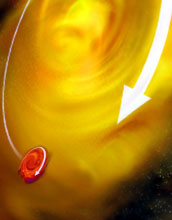Multimedia Gallery
Multiple Star Formation (Image 3)
Multiple Star Formation (Image 3)
A third, smaller disk and protostar joins the system, either through the same fragmentation process or by being captured gravitationally by the larger protostars rotates in this artist's conception of the proposed formation process of the young, multiple-star system L1551 IRS5, as revealed by observations using the National Science Foundation's Very Large Array (VLA) radio telescope. [Image 3 in a series of 4. See Image 4.]
The young, still-forming protostars are enshrouded in a cloud of gas and dust--making them invisible to optical telescopes--some 450 light-years from Earth in the direction of the constellation Taurus. This object was first discovered in 1976 by astronomers using infrared telescopes. Then in 1998, a VLA study showed two young stars orbiting each other, each surrounded by a disk of dust that may, in time, congeal into a system of planets.
There are two popular theoretical models for the formation of multiple-star systems. First, that the two protostars and their surrounding dusty disks fragment from a larger parent disk. Second, is that the protostars form independently and then one captures the other into a mutual orbit.
More recently, astronomers reexamined L1551 IRS5 using improved technical capabilities that greatly boosted the quality of their images and yielded important clues about how such systems are formed. The new observations showed that the disks of the two main protostars are aligned with each other, and also are aligned with the larger, surrounding disk. In addition, their orbital motion resembles the rotation of the larger disk. This 'smoking gun' supports the fragmentation model. (Date of Image: unknown)
Credit: Bill Saxton, NRAO/AUI/NSF
Images and other media in the National Science Foundation Multimedia Gallery are available for use in print and electronic material by NSF employees, members of the media, university staff, teachers and the general public. All media in the gallery are intended for personal, educational and nonprofit/non-commercial use only.
Images credited to the National Science Foundation, a federal agency, are in the public domain. The images were created by employees of the United States Government as part of their official duties or prepared by contractors as "works for hire" for NSF. You may freely use NSF-credited images and, at your discretion, credit NSF with a "Courtesy: National Science Foundation" notation.
Additional information about general usage can be found in Conditions.
Also Available:
Download the high-resolution JPG version of the image. (541 KB)
Use your mouse to right-click (Mac users may need to Ctrl-click) the link above and choose the option that will save the file or target to your computer.

